HARD AT WORK
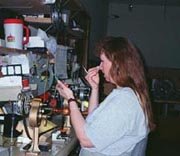
Mom works sooooo hard!!!!

Amy takes 6000 pictures a day

Tim filming

Mom and that big processor
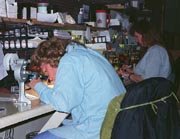
Jan and Mom QC-ing

Juan carries all those heavy boxes!
 Mom looks for mistakes
Mom looks for mistakes
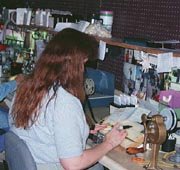
Mom marks the mistake to be cut out
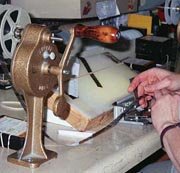
Mom cuts out the bad film
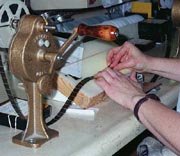
And then Mom splices in the good film
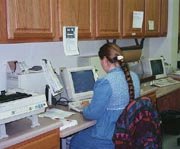
 Cyndi sends out the finished microfilm to all the clients
Cyndi sends out the finished microfilm to all the clients
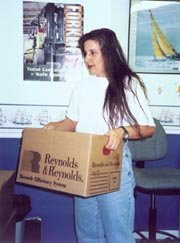 Aunt Elsie picks up and delivers film for a lot of banks
Aunt Elsie picks up and delivers film for a lot of banks
|
MOM'S DAY AT WORK
 by FUZZ
by FUZZ
Mooch and I have heard Mom talk about work, but we really don't understand what that means. She says she works at a place where they make "microfilm". So Mooch and I did some research and we learned a lot!
MICROFILM
As libraries, government bureaus, and businesses increase in size, they must find ways of storing their records without requiring ever more building space. Often they choose to do this with microfilm. Microfilming, or microphotography, is a mechanical process by which anything drawn, written, or printed can be photographed and reduced in size--often to just 1 percent of the original--onto strips of film. Using this system, large amounts of information can be stored in very little space.
Microphotography requires special cameras that are adapted to the type of material to be photographed, such as newspapers, bound volumes, or loose-leaf material. Each page of the material is microphotographed in order on a roll of film--usually a 100-foot (30-meter) roll of 16-millimeter or 35-millimeter nonflammable safety film. The film can then be read through a desk projector that returns the copy to approximately its original size.
The microfiche system is a variation of the microfilm. The term comes from the French fiche, meaning "index card." Microfiche is based on the same principle as microfilm but uses sheets of film, or cards, instead of rolls so that the reader need not go through the film frame by frame to find a specific item. Typically microfiche sheets measure 4 by 6 inches (10 by 15 centimeters). As many as 1,800 pages can be recorded on each card, though generally about 200 pages, reduced 18 to 72 times, are fit onto a card. Ultramicrofiche employs the same format as microfiche and uses the same size cards. The images are reduced 90 times or more, however, so that thousands of pages can fit on a single card.
In both microfilm and microfiche systems, there are reader-printers that can produce photocopies of pages. Filmed information can also be coded for retrieval by computers designed for this function.
Nearly every branch of the federal government uses microfilm or microfiche systems to reduce bulky files and to safeguard duplicate copies of valuable records. The United States Bureau of the Census is one of the largest users of microfilm. Census documents, bound in huge 25-pound (11-kilogram) ledgers, occupy miles of shelving and cover thousands of square feet of floor space. Microfilming reduces the amount of floor space required by 95 percent.
Libraries save space by storing old newspapers, magazines, and other publications on microfilm and microfiche systems. Ten issues of The New York Times, averaging 830 pages, can be recorded on a single 100-foot roll of 35-millimeter microfilm. Microfilming also allows libraries to duplicate the pages of rare and fragile books and manuscripts and to substitute compact film for bulky papers and reference materials that are not often used. Microfilm and microfiche are used by banks to record checks, deposits, loan agreements, and other transactions; by engineering firms to duplicate complicated drawings; and by commercial firms to store parts and repair manuals, inventories, and records that are vital to the basic maintenance of their businesses.
|
Now that we know what microfilm is we decided to find out just what Mom has to do with this microfilm. So we did some more research and this is what we found out:
Where Mom works they have lots of really big cameras (bigger than Aunt Dodie's new camera). They are so big that they sit on a desk and a person has to sit there and make them go! They film lots and lots and lots of papers all day long. Most of the stuff they take all those pictures of are hospital charts and medical records. They can take 2500 pictures (or more) on one of these rolls of film. WOW!! When the camera operator has taken all those pictures and the roll is full, then the roll goes to the Processing department, where the film is developed. Then the roll of film goes to the Quality Control (QC) department, and this is where Mom works. When Mom gets the roll of film she goes through the whole roll and looks at every picture, to make sure it was filmed the right way. If Mom finds something wrong with the pictures on the film, then she has to fill out a "Refilming Note" and those pictures have to be filmed again. She sends this refilming note out to the warehouse, where all the papers are stored, and then her friend Juan, who works in the warehouse, brings her the papers that she has written on the refilming note. Then she takes those papers to the "Refilming Camera" where they take pictures of them again, develop them again, and finally send them to Mom again. Then she gets to "cut and splice." Mom likes this part. She cuts out the bad pictures and splices in the good pictures. There are several people in Mom's QC department who check the rolls of film and fill out the refilming notes, but Mom gets to cut and splice in all of the refilming. It keeps her really busy! When Mom is all finished splicing in the refilming, she gives the roll of film to her friend Cyndi who works in the Shipping department. Then Cyndi sends the film to the company who sent the papers to Mom's work in the first place. Wow!
And that's not all that Mom does!! Mom's friend Elsie drives around town part of the day and goes to all the different banks and picks up more microfilm. The banks have their own big cameras to film papers, but then they send the film to Mom's work to be developed. When the bank film goes to QC after Processing it goes straight to Mom. She looks at the bank film to see if it is ok, then she gives it back to Elsie so she can take it back to the banks and pick up more film. WOW!! No wonder Mom is gone all day - she has so much to do!!
Close this window to return to reading Mooch's Diary
|
 by FUZZ
by FUZZ





 Mom looks for mistakes
Mom looks for mistakes




 Cyndi sends out the finished microfilm to all the clients
Cyndi sends out the finished microfilm to all the clients
 Aunt Elsie picks up and delivers film for a lot of banks
Aunt Elsie picks up and delivers film for a lot of banks